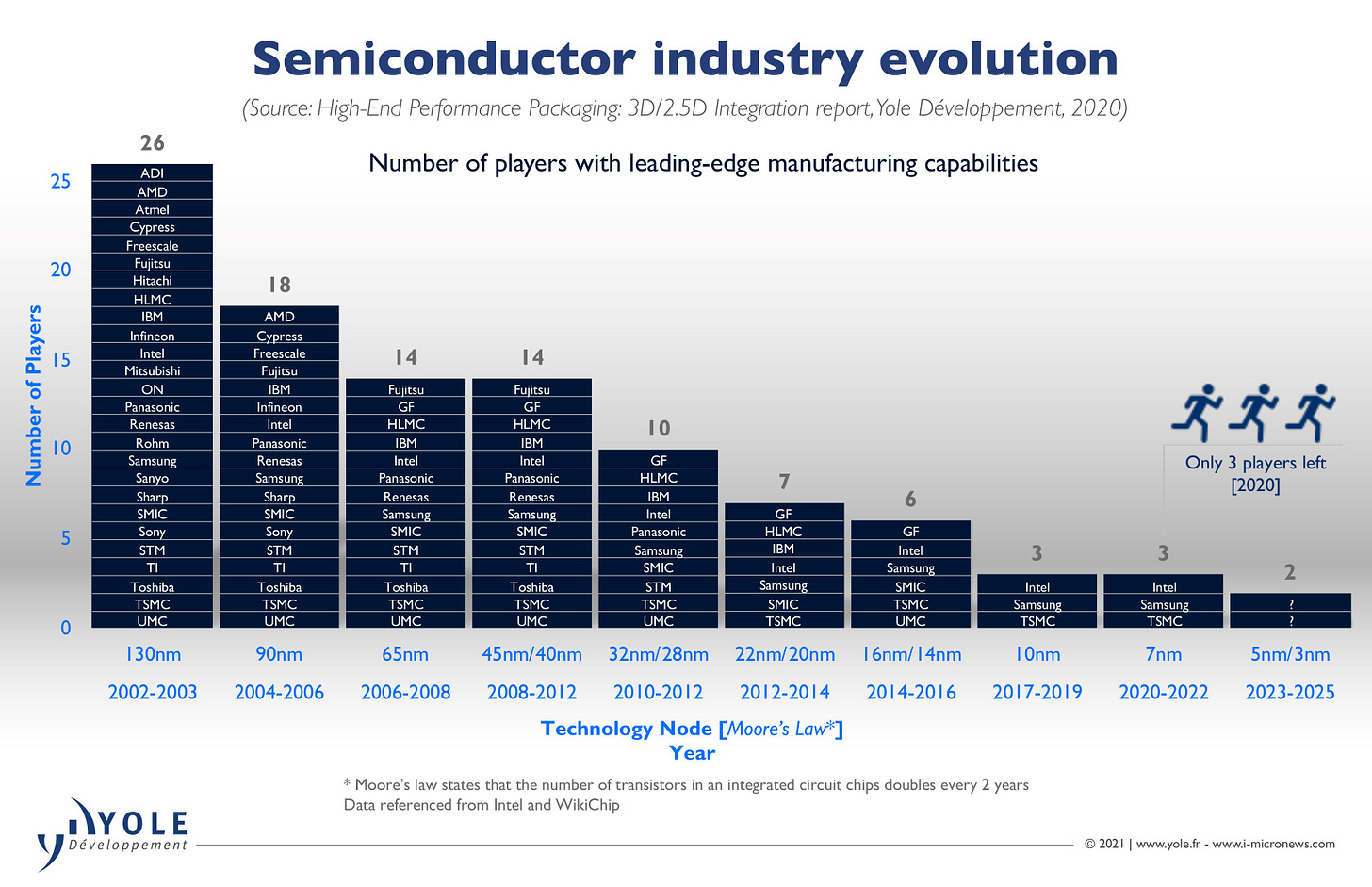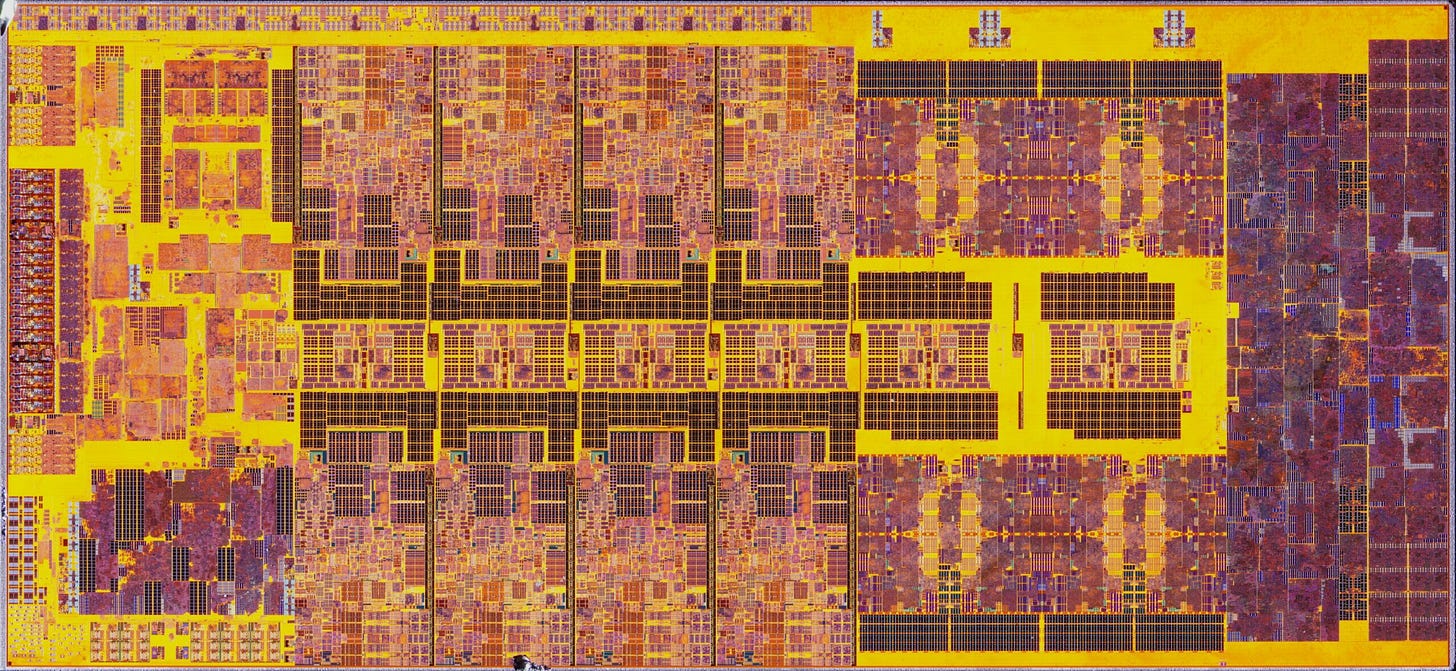RIP Gordon Moore: The Law That Inspired an Industry
"It was never a scientific law but a human aspiration that the semiconductor industry kept to. That’s magic in itself."
The following piece is by Doug O’Laughlin, one of the ChinaTalk Chip Avengers and the author of the fantastic Fabricated Knowledge newsletter.
Gordon Moore famously coined his law in 1965 in the Electronics Magazine while working at Fairchild. He made a simple observation, and then the industry took it to heart. Moore would leave Fairchild with Robert Noyce and co-found Intel. The observation that would then become Moore’s law is below:
The complexity for minimum component costs has increased at a rate of roughly a factor of two per year (see graph on next page). Certainly over the short term this rate can be expected to continue, if not to increase. Over the longer term, the rate of increase is a bit more uncertain, although there is no reason to believe it will not remain nearly constant for at least 10 years. That means by 1975, the number of components per integrated circuit for minimum cost will be 65,000.
At some point, the continued doubling became a benchmark that the industry aspired to and continued to push far past 1975. The eventual law settled doubling every two years, and if you notice, Moore said that the scaling could last longer than a decade, and it ended up lasting longer than even Moore could have anticipated.
The longevity of Moore’s law changed our lives in huge ways that I think Gordon Moore would have never anticipated in 1965. The common anecdote is to compare the billions of smartphone transistors to an inferior room-sized computer from 1965. I think focusing on the impacts of shrinking chips is much more profound.
In 1965, the primary method to communicate with people was via letters and landline telephones; today, we can text or FaceTime anyone we want around the world in real-time. That’s the power of Moore’s law.
In 1965 there were scheduled programs to watch on the TV, and you’d tune into channels or frequencies that broadcast shows. That concept feels quaint given the on-demand, almost limitless content we have on the internet, on Netflix, or elsewhere. That’s the power of Moore’s law.
In 1965 we barely knew the causes of cancers, and the advancements in medical imaging, diagnosis, and computation led to crushing a deadly and vicious global pandemic with a vaccine in just two years. While the medical community deserves all the credit for solving the COVID crisis, the work was done and amplified on computers. We even mapped the entire human genome! That’s the power of Moore’s law.
We can purchase almost anything we want, at any time, to be received at our doorstep the next day in most parts of the developed world. The internet and the infinite ways it’s changed all our lives are part of the power of Moore’s law. By heralding better and faster semiconductors, Moore’s law changed the fabric of our lives.
I could go on. Moore’s law made computing ubiquitous and gave us amounts of computation that would have been gargantuan in 1965 yet trivial in 2020. That excess computing power gave us the bandwidth to create things like the internet, smartphones, or any electronic invention. And now, as a result, our lives are profoundly different from 1965.
We all owe Gordon Moore our thanks. But the law that Moore invented is dead, according to many. Still, before we talk about that, I want to note that it was never a scientific law but a human aspiration that the semiconductor industry kept to. That’s magic in itself. Let’s talk about the end of Moore’s law and why Moore’s spirit lives onward in many ways.
Moore’s law was alive and well clearly into the 2000s, but at some point, it broke down. I think the death of Moore’s law focuses on the end of planar shrink and energy scaling, like the breakdown of Dennard scaling.
If you’re paying a bit closer attention, things are still improving but through a new playbook of More than Moore’s law. This includes trends like advanced packaging, heterogeneous computing, specialization, and other clever tricks to improve transistor density at a system level, not at a micro level. Moore’s law’s spirit is alive!
The end of Moore’s law and the clear sea change made me want to jump into the semiconductor space from my previous background. One of my first posts discussed the void that Moore’s law’s death would hold. Most of the things I talked about then still are true today.
But it’s not like progress has stopped, and frankly, the “more than Moore” playbook is the story of the industry re-inventing itself to cram more transistors effectively in a world where planar shrink no longer worked. That sounds a lot like Moore’s amended law.
We are still trying to improve transistor density, and the industry is doing an amazing job at keeping to that. In that sense, Moore’s spirit lives on clearly because Moore’s law never was a scientific law to begin with, just an aspiration. An aspiration that lasted a lot longer than we could have anticipated.
Laws can have two meanings, as a scientific law or legal law. The latter is a social construct that we all agree upon, like that we all agree that our government has the rule of law over its citizens. In essence, that’s a human norm we all believe in. The magic of Moore’s law is that we took a human norm and upheld it as if it were a scientific law for decades.
The doubling of transistors every year wasn’t a given. It was clear it could continue for some time, but semiconductor process and design engineers didn’t have to double transistor density every 18 months. They worked hard to hit this goal, even as it became exponentially harder to maintain. Sure, the companies benefited from upholding the law, but many companies fell off of Moore’s law’s pace as it progressed.
Semiconductor companies truly had no reason to give their customers that much excess. But by creating a roadmap that the entire world counts on, technology companies could bet on tomorrow with conviction. Opting into Moore’s law was a choice, an internal compass to push the world forward. And by giving the world a broad roadmap to improve upon, companies could make bold bets on an advancing world.
Take Netflix, for example.
When Reed Hastings started Netflix, he always knew that Netflix would stream video to its customers online. Shipping DVDs was a stop-gap. That was in 2000, years before streaming video was possible. But that bold bet was only possible because Reed HastingS knew exponential progress was the norm. Hastings knew that Moore’s law would eventually enable computation to stream video on the internet.
Many companies have been built on the future moonshot of knowing that computing would improve exponentially. Moore’s law enabled everyone to safely believe that tomorrow would be better in the electronics industry, and to Gordon Moore, Intel, and semiconductor engineers everywhere, we have to thank them.
The secret of Moore’s law was that it was never an actual law but a benchmark that semiconductor companies held themselves to. By keeping up with this torrid pace, the end game where we arrived is a place that was markedly different from 1965.
When Gordon Moore observed Moore’s law in 1965 and that the rate of transistor density would improve for decades to come, I don’t think they could have ever anticipated the destination.
EUV, the quest to make smaller extreme ultraviolet light is truly a scientific miracle but just one stop on the epic quest started by Moore. No one could have guessed the billions of dollars and years of development it would take to harness EUV in 1965.
The shift to 3D transistors, new non-silicon materials, and the miracle of every step of semiconductor fabrication was not anticipated in 1965, a world that made semiconductors at a human scale. Photolithography was done on a benchtop, and you could physically see the transistors in the famous Intel 4004 MCU.
No one could have anticipated the epic quest from the Intel 4004 (image below) to Intel’s Raptor Lake (next image).
Compared to Alder Lake, one of Intel’s most recent CPU designs. At best, you can understand the groupings of the die shot, but this is way past human comprehension.
The epic quest Gordon Moore set the semiconductor industry off on changed our lives. And the destination of that journey is a world where the unimaginable is possible. In 1965, no one could have anticipated a world where ChatGPT could cogently pass law school exams or cars were at the cusp of driving themselves. Moore could have never imagined the consequence of his law because exponential progress is uniquely rare and even harder to hold onto.
Rest in Peace, Gordon Moore. The law you coined became a benchmark, and that benchmark of progress changed the world. I also want to thank everyone who made this imaginary law a reality. It was a choice to follow the law and pursue the path of exponential progress. The engineers that worked tirelessly to design each successive generation deserve credit for hoisting us higher. It was coined by a man but became a reality by the hundreds of thousands of engineers at Intel and other companies globally. Their work is the story of human progress.
And Moore’s spirit is still alive as we pursue Gate All Around (GAA), Backside Power Delivery Networks, specialized Chiplet architectures, and GPUs that can train models that are at human-like comprehension. The simple gains of linear progress are over, but the industry is still progressing to places unknown. All in the spirit of Gordon Moore.
It’s not an understatement to say we all live in Moore’s legacy; for that, I couldn’t be more grateful.
My favorite book about Moore personally is the Intel Trinity. It explains the gods of Intel, Robert Noyce, Gordon Moore, and Andy Grove. Each has an important part to play in Intel, but Gordon Moore was always the thinker. He’s always been characterized as the quieter counter part to Noyce’s charisma—the hero of Andy Grove. Moore, like his law, was a constant force in the industry and Intel for years. And to many one of the most beloved of the founders of Intel.
I cannot say this enough, thank you, Gordon Moore. Your legacy is being carried on by hundreds of thousands of engineers worldwide. They have hoisted your law into realms you could never believe, and I think that everyday they honor your legacy by making smaller, more advanced transistors that, in turn, are used in all aspects of our lives. The spirit is alive!
Thanks, everyone, for reading. If you enjoyed this, share this piece. Also, hug someone who works in the semiconductor industry. They don’t get the appreciation they deserve for making this law a reality.







